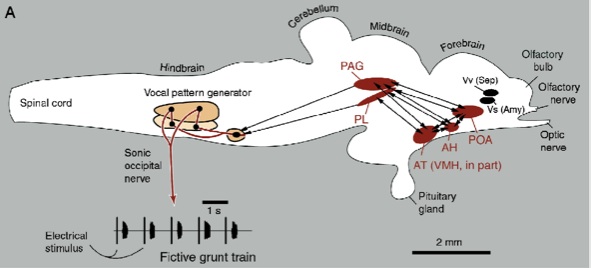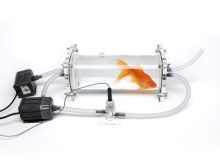Department of Biology
Renn Lab
Student Project Ideas
(check back often as new ideas will be added)
(see previous ideas, some of which are still viable)
These pages include scientific ideas that supplement my own research interests. I provide a short summary and a few references but students are encouraged to propose independent ideas.
2. MATERNAL BEHAVIOR: AFRICAN CICHLID Astatotilapia burtoni (details):
Background
For over thirty years, the African cichlid fish, Astatotilapia burtoni, has been an important model system to study the mechanisms underlying socially mediated behavioral change, with the focus being male dominance behavior. In this species, at any given time, 20-30% of males are dominant. The dominant males are brightly colored (either blue or yellow) and actively defend territories for mating. The remaining subordinate males mimic females by schooling and displaying cryptic coloration (silver gray) but they are not reproductively active. Many behavioral, physiological, and molecular studies have investigated this complex social behavior (Fernald 2003). The Renn lab has access to two different stocks that have subtle, but interesting differences in behavioral phenotype (Renn et al 2009).
2.A) The Effect of Early Experience on Adult Behavior
A fascinating body of research, derived largely from the lab of Michael Meaney and colleagues, reports on epigenetic inheritance of behavioral phenotype in rats. Rat pups from litters in which the mother engaged in high levels of maternal care (licking and grooming) grow up to be good mothers themselves. This is not genetic as has been demonstrated by repeated cross-fostering experiments (for review see Sapolsky, 2004). While many studies in other organisms have shown maternal effects, the remarkable aspect of this research is the level of mechanistic detail that is available. Researchers have identified the regulatory regions of specific neurohormones receptor genes that are "methylated" so as to alter the expression level in a semi-permanent fashion. This causes altered level of responsiveness to neurohormones and manifests as altered behavior in many respects. Recent studies have shown, in a cichlid speices, that fish also undergo life-altering influences of early social environment (Arnold and Taborsky 2010). I am curious to know if the good mother / bad mother phenotype in our A. burtoni wild stock and lab stock have a long-term influence on the behavior of their progeny. In fact, this good mother / bad mother dichotomy may be epigenetic itself.
2.B) The Influence of Metabolic Regulation on Maternal Behavior *
Mouthbrooding is not uncommon in cichlids .Fertilized eggs are cleaned and churned in the buccal cavity, during which time females voluntarily starve themselves. This period of mouthbrooding results in stunted growth and loss of body mass despite a significant reduction in metabolic rate (Mrowka and Schierwater, 1988). The increased loss of body mass observed for lab stock females compared to wild stock females may be due to an inability to appropriately decrease metabolic rate. Therefore, the observed “bad mother phenotype” in lab stock females may result in the inability to regulate metabolic rate. The inhibition of food consumption in mouth brooding females is controlled by two mechanisms: the short-term physical stimulus of eggs in the buccal cavity and the long-term neural mechanisms that regulate feeding. The complex neural integration mechanisms are known to be conserved across vertebrates such that many neuropeptides and hormones (e.g. Forlano and Cone 2007; Volkoff et al. 2005). Using metabolic rate measures and qPCR to quantify gene expression levels, we aim to determine whether these long-term mechanisms are compromised in the lab stock, possibly resulting in the inability to inhibit food consumption after release of the fry.
2.C) The Social Neural Circuit *
There appears to be a network of brain regions that regulate social behavior in all vertebrates (Goodson 2005). While the core network is conserved, variation between species may account for species differences in social behavior. Previous work in the Renn lab has identified long lists of genes that are differentially regulated between aggressive and non-aggressive males; maternal and gravid females; or between aggressive individuals in different species. We aim to use antibody staining and in situ hybridization to localize brain regions that produce gene expression differences so that we can correlate gene networks and neural networks. This work parallels that of my collaborator, Hans Hofmann (Munchgrath and Hofmann 2010).

2.D) The Emergence of Leadership
While most of the behavioral studies that have been conducted with A. burtoni use focal animal observations, more recent studies have expanded the observation strategy to include complicated social situations. We find that individual males are highly attentive to other animals in the tank. We have noticed that when there are two territorial males in a tank, they seem to copy each other's movements. Similar behavior has been described for many animal groups such that certain individuals consistently appear at "lead" coordinated movements. It is not well understood what social signals or internal motivation causes "leadership" to emerge (Harcourt 2009) . The cichlid system offers a good model with which to address the behavioral, physiological and even molecular mechanisms that contribute to leader and follower phenotypes.
1. GENOME EVOLUTION (details):
1.A) Gene Duplication of Genomic Architecture of Adaptive Radiation *
1.B) Bioinformatic Analysis of Cichlid Genomes
2. MATERNAL BEHAVIOR: AFRICAN CICHLID Astatotilapia burtoni (details):
2.A) The Effect of Early Experience on Adult Behavior
2.B) The Influence of Metabolic Regulation on Maternal Behavior *
2.C) The Social Neural Circuit *
2.D) The Emergence of Leadership
3. GENDER BIASED BEHAVIOR: AFRICANC CIHCHLIDS Julidochromis(details):
3.A) Sex-Role Reversal *
3.B) RNA-seq may replace Microarray analysis. Are we ready?
(* indicates ongoing projects that are a main focus in our funded research programs)




